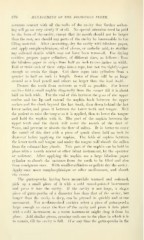Page 672 - My FlipBook
P. 672
670 MANAGEMENT OF THE DECIDUOUS TEETH.
accurate contact with all the walls of the cavity that further soften-
ing will go on very slowly if at all. No special attention need be paid
to the form of the cavity, except that its mouth should not be larger
than the rest, nor should any parts of the cavity be inaccessible to the
filling material. After excavating, dry the cavity with bibulous paper,
and apply camph()-j)ht'ni(pu', oil of cloves, or carbolic acid, to sterilize
any softened dentin which may not have been removed. For drying
cavities, prepare paper cylinders, of different sizes, as follows : Tear
the bibulous pai)er in strips from half an inch to two inches in width,
lioll or twist each of these strips into a rope, but not too tightly — just
enough to retain the shape. Cut these ropes into cylinders from a
quarter to half an inch in length. Some of these will be as large
around as a lead pencil and others no larger than the lead itself.
Protect the tooth from moisture as well as possible. For lower
cavities fold a small napkin diagonally from the corner till it is about
half an inch wide. Put the end of this between the gum of the upper
canine and the lip and extend the napkin back between the upper
molars and the cheek beyond the last tooth, then down behind the last
lower molar, and press it between the lower teeth and tongue. Tell
the patient to raise the tongue as it is applied, tlien to lower the tongue
and hold the napkin wdth it. The part of the napkin between the
upper teeth and the cheek will cover the mouth of the duct of
Steno, and prevent or absorb the flow of saliva. It is better to cover
the mouth of this duct with a piece of spunk about half an inch in
diameter before applying the napkin. The folds of napkin between
the lower teeth and tongue and under the tongue will absorb the saliva
from the submaxillary glands. This part of the napkin can be held in
place with a mouth mirror or other blunt instrument, by the operator
or assistant. After applying the napkin use a large bibulous paper
cylinder to absorb the moisture from the tooth to be filled and also
from contiguous ones. With smaller cylinders or pellets dry the cavity.
Apply once more campho-phenique or other medicament, and absorb
the excess.
The gutta-percha having been meanwhile warmed and softened,
pick up a small piece of it with a cold round-pointed instrument
and press it into the cavity. If the cavity is not large, a single
piece of gutta-percha of a diameter less than that of the cavity, but
longer than the cavity is deep, can be pressed in quickly and at one
movement. For medium-sized cavities select a piece of gutta-percha
large enough to cover the floor of* the cavity and press it into place
with a cold instrument, as a Avarra instrument might drag it from its
place. Add similar pieces, pressing each one to the place in which it is
to remain, till the cavity is full. If at any time the gutta-percha in the


